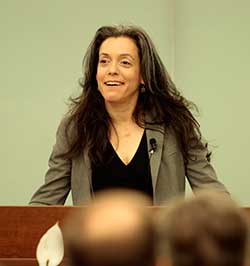University of West Georgia Hosts Lectures on Alexander Hamilton
by Joy Esiemokhai

Dr. John Ferling
Despite being part of the group of Founding Fathers who built the United States, Alexander Hamilton has always been somewhat of a background character. UWG’s Ingram Library continues to host a national traveling exhibition chronicling the achievements of the man whose face is emblazoned on the $10 bill titled “Alexander Hamilton: The Man Who Made Modern America.”
Three presentations by prominent historians were hosted as part of the exhibit, each one focusing on one unique aspect of Hamilton’s life by examining his legacy and his vision for the nation through the documents he wrote and published, the institutions he shaped, and the conflicts that made him notorious in his time.
The first presentation titled “Alexander Hamilton: Writing and Ratifying the Constitution” was held on Tuesday, September 17, at the Ingram Library and led by Dr. Keith Pacholl, a UWG Associate Professor of History and Early American History specialist. Dr. Pacholl detailed Hamilton’s vehement efforts in writing and ratifying a new and more solid constitution for the new United States at the 1787 Constitutional Congress. At a time when there was a decentralized system of government, with most of the power with states, Hamilton pushed for the dissolution of the Articles of Confederation and for a more centralized constitution. As one of three delegates from New York, he was also pivotal in getting the state of New York to ratify the new constitution. According to Dr. Pacholl, Hamilton’s efforts “emphasized and supported the political unity of Americans and a system of checks and balances.”

Dr. Joanne Freeman
The second presentation, “Alexander Hamilton: Vision, Leadership, Ruin,” took place on Tuesday, September 24, and was led by Dr. John Ferling, UWG Professor Emeritus of History. The lecture tackled Hamilton’s Revolutionary and post-Revolutionary War successes, including his role as George Washington’s right-hand man, his combat efforts in seven major battles, his role as the first treasury secretary, his founding of the Federalist Party and his later role of Inspector-General of the Army. Dr. Ferling highlighted Hamilton’s determination to restore the woeful economy of the new United States, laying out plans for a strong central government and central bank, along with a funded national debt. His plans are still in operation in today’s United States and he is widely regarded as the founder of America’s financial system and therefore, modern America. Hamilton’s policies, however, were often met with great opposition from both his political opponents and allies, and these oppositions led to his political ruin. “In the course of making modern America, great political change had swept the land and those changes ruined Alexander Hamilton,” Dr. Ferling said.
Hamilton made a number of political enemies due to his outspokenness and this was the contributing factor to the duel that led to his death. The third presentation “Dueling as Politics: The Burr-Hamilton Duel,” was held on Monday, September 30 and led by Dr. Joanne Freeman, Professor of History and American Studies at Yale University and authority on dueling in early America. The lecture detailed the rituals and conditions necessary for a duel to take place. Hamilton died from a mortal injury on July 12, 1804, following a duel with Vice President Aaron Burr the previous day. The long history of political tension and feud between Hamilton and Burr reached a head during the 1804 gubernatorial race, which Burr lost. Hamilton wrote a series of letters and articles defaming Burr, which culminated in Burr issuing a dueling challenge to Hamilton and Hamilton’s tragic death. Hamilton’s death had a lasting impact on both his Federalist party and Burr’s honor and political career, as the Federalist party never fully regained its “Hamilton-era” glory and Burr never regained the honor he killed for.
Alexander Hamilton remains an immensely influential but flawed figure of early United States. The presentations sought to make sense of his talents, his hard work and his notoriety. The Hamilton exhibit remains on display at the Ingram Library until October 14, 2013, and is free and open to the public.
For further information, visit www.westga.edu/library or contact Catherine Hendricks at chendric@westga.edu or 678-839-5337.
